The Samsung Galaxy Note 9 is a little bigger, a little more colorful, and a little more powerful than all prior Note phones, but be warned: it’s also a lot more expensive.
It’s the biggest Android phone that will grab your attention in 2018, with a sizeable 6.4-inch Super AMOLED display, a huge 4,000mAh battery for all-day performance, and up to 512GB of storage and 8GB of RAM.
Slot in a 512GB microSD card (which Samsung will gladly sell you), and you can have the first mainstream 1TB phone in your hands.
Good news – the Note 9 doesn’t actually feel any bigger than last year’s 6.3-inch Note 8, and it inherits a bunch of this year’s 5.8-inch Galaxy S9 and 6.8-inch Galaxy S9 Plus features.
The camera is better, with a dual 12MP rear setup that has dual-aperture technology, and can record Super Slow Mo videos. AR Emoji is back with some finer avatar customizations, but rest assured, your avi will still look nothing like you, according to our early tests.
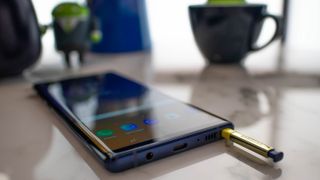
Exclusive to the Note 9 camera are automatic scene optimizer and flaw detection features that enhance photos (Samsung has a habit of rolling these features out to older phones later on).
The S Pen now has Bluetooth for remote-controlled shortcuts that, unlike the Bixby button, are customizable. Want to pose for a photo 30 feet away? This S Pen can help you do that and more.
Bad news – the price feels much bigger. Get ready to pay iPhone X-level prices for the entry-level 128GB and 6GB model. Ouch. The Note 9 is meant for power users, according to Samsung – the physical size, storage size, price, and battery capacity all tell us that.
The company sees Note 9 buyers as people who spend a lot of time on their phone and want the best of the best – they buy the best AV receiver, the best TV, and so forth.
We’re continuing to test the Note 9, but we can already tell that it’s a contender to unseat the Galaxy S9 Plus as our top smartphone recommendation – that is, if you want to own a giant, feature-filled phone with a stylus and hate saving money.
Ongoing Samsung Galaxy Note 8 deals are the biggest threat to this upgrade that, ironically, is all about going big in a variety of small ways.
Check out our hands on video below to see the Galaxy Note 9 in action:
Release date and price
- Release date is August 24, with an iPhone X-like price
- $1,000 (£899) for 128GB/6GB, $1,250 (£1,099) for 256GB/8GB
The Samsung Galaxy Note 9 release date is on August 24, sooner than anyone had expected a year ago. The Note 8 came out on September 15 in the US and UK last year (September 22 in Australia).
The theory is that Samsung wants to rush out the Note 9 to beat the iPhone 11 and iPhone 9 announcement expected for early September.
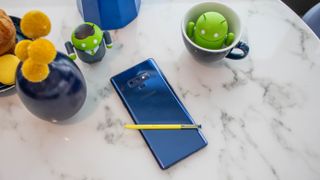
Talking of Samsung competing with Apple, the Note 9 price rivals that of Apple’s handset, rather than undercutting it as we'd hoped.
The Galaxy Note 9 price is $1,000 (£899) for the phone with 128GB of internal storage and 6GB of RAM, and $1,250 (£1,099) for 512GB and 8GB of RAM.
Yes, that entry-level 128GB configuration does double the iPhone X's 64GB of storage for the same price, but it's also a hike of $70 (£30) over the Note 8 launch price.
Samsung will sell the phone unlocked in the US on release day, and also through carriers like Verizon, AT&T, Sprint and T-Mobile. Pre-orders in the US begin tomorrow, August 10.
Note 9 colors in the US are Ocean Blue with a yellow S Pen (it also writes in yellow for the ultimate color contrast) and Lavender Purple with a purple pen (which writes in purple digital ink).
The Samsung Note 9 release date in the UK is August 24, with pre-orders opening on August 9.
We don't have dates or prices for Australia and other regions of the world just yet, but we'll update this hands on review as soon as we know more. Other regions may get Black and Copper colors, we were told by Samsung – colors are region-dependent.
New S Pen magic tricks
- Bluetooth stylus has custom shortcuts
- Great for remotely taking photos, works up to 30 feet away
- Charges quickly while embedded in the phone
The new S Pen is the star turn of the Note 9 show, capable of performing Bluetooth-connected magic tricks from up to 30 feet away.
Samsung has managed to squeeze a small battery and tiny Bluetooth Low-Energy antenna into the otherwise unchanged stylus so that it can perform various remote functions, and we're impressed.
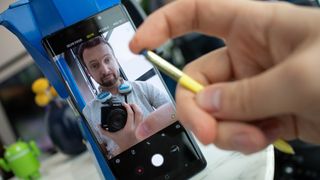
What can you do exactly? We were able to remotely launch the camera app with a long press of the clicky end of the S Pen, flip the camera to selfie mode with a single short press, and snap a group photo with two presses.
It’s much easier than setting the camera timer, which Samsung hid in the camera settings menu last year, and less awkward than waving your hand in front of the lens to trigger the gesture-initiated camera timer.
Samsung is making S Pen shortcuts customizable. Here are the ideas mentioned:
- Camera: Flip the camera / take a photo
- Camera: Flip the camera / record a video
- Music Player: Play and pause music / skip to the next track
- Photo Gallery: Advance to the next photo / cycle back to a previous photo
Samsung is putting a software development kit (SDK) out there for non-core third-party apps to take advantage of this shortcut, so the shortcuts will be customizable as long as app developers support the functionality.
The S Pen does need to be charged, but Samsung claims 40 seconds of charge time will net you 30 minutes of standby battery.
We’ll have to test how long a full charge lasts in our full Note 9 review, but we can already tell that keeping the S Pen topped up will be much easier than charging the iPad Pro’s Apple Pencil.
Simply embedding the S Pen inside the phone charges it, and when it’s not in use, that’s where you typically put it. The Apple Pencil has nowhere to hide, and walking around with in the Lighting port is rather dangerous. Samsung’s years of stylus-making experience is obvious here.
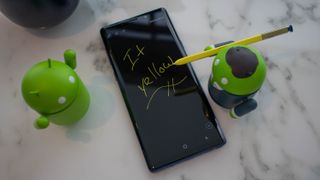
The Blue Ocean Note 9 has the more dynamic yellow S Pen for a nice contrast. It writes in yellow digital ink, while the Lavender Purple phone has a purple pen and purple digital ink.
All colors support the same Air Command functionality. You can draw, jot down notes, annotate screenshots, translate foreign text, and send Live Messages (last year's S Pen gimmick).
Samsung says the Bluetooth functionality allows for the evolution of the S Pen, but we can’t help but notice another contrast.
Shortcuts like snapping selfies remotely can ‘unlock a whole different level of photography’, according to Samsung, and while that sounds useful for dramatic selfies (the example given is laying tired on the couch and taking a hands-free photo), the business-class Note 9 may not be the right audience for that. But it’s a nice idea nonetheless.
Your first 1TB-ready smartphone
- 512GB of internal storage with 8GB of RAM
- 128GB of internal storage with 6GB of RAM
- Additional 512GB microSD card can up storage to 1TB
It’s no surprise that Samsung, among top manufacturers, is the first to produce a 1TB-ready smartphone, a capacity that rivals that of most laptops people buy today. Samsung makes both the internal 512GB flash drive and a variety of 512GB microSD memory cards.
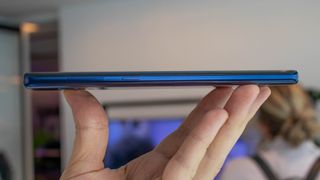
The Note 9 is billed as the phone that will never run out of physical storage space. Uninstalling games and deleting movies you’ve downloaded isn’t something you’ll need to worry about here – take all the photos you want at full resolution, and all the 4K video you want, no compromise needed. 8GB of RAM is also likely to work best for Samsung’s Dex desktop mode, second screen workflows, and virtualization software.
DeX itself is easier to use on the Galaxy Note 9, as unlike on the Note 8 where a physical dock was required for it to work, this time round all you need is a simple HDMI dongle for the PC-like desktop experience.
Of course, the 512GB storage and 8GB RAM are what send the Note 9 price skyrocketing; the entry-level 128GB and 6GB of RAM configuration is ‘cheaper’ by $250.
At these prices, the questions you have to ask yourself are: Do I really need a 1TB phone? Am I going to also spend money on a 512GB microSD card? And will cloud storage make all of this irrelevant in the future?
The 4,000mAh battery
- Much larger battery at 4,000mAh
- Galaxy S9 had 3,000mAh and S9 has 3,500mAh
- Fast Charging and Fast Wireless Charging supported
The Note 9 battery capacity has also been unshackled, breaking through the 4,000mAh ceiling.
Samsung is finally comfortable enough to give us a larger battery following the Note 7 recall, and it promises that its eight-point safety check will mean no repeat of the fires we saw two years ago.
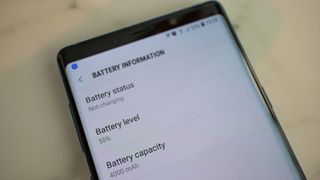
Battery life is being touted as all-day, and that's for Note power users, which means moderate use should see you into day two without a problem.
While the storage sizes come in two configurations, the battery size, thankfully, is common to both devices. You also get Fast Charging and Fast Wireless Charging capabilities.
Design, display and other specs
- Expansive 6.4-inch display and minor dimension changes
- Includes fingerprint sensor, microSD slot and headphone jack
Samsung’s Super AMOLED display doesn’t need to change to look great. It’s consistently the best smartphone screen in the world until the next Samsung phone launches, every year.
The 6.4-inch Note 9 screen did grow by a tenth of an inch over the 6.3-inch Note 8 display. It’s a change few will notice without breaking out the measuring tape (which we used in our testing).
The nearly bezel-less Infinity Display is bright and punchy. And, even if the tall 18:9 aspect ratio (or in this case 18.5:9) is on just about every flagship phone in 2018, Samsung’s curved edges are unmatched.
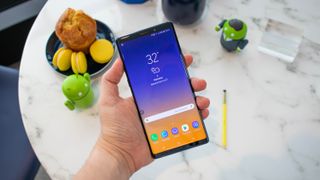
The size of the Note 9 has changed from the Note 8, too, but maybe not how you think. It’s slightly wider, and slightly shorter, than the Note 8, with dimensions of 161.9 x 76.4 x 8.8mm (the Note 8 was 162.5 x 74.8 x 8.6mm).
It also weighs a bit more: 201g vs 195g. This isn’t a small or light phone, but it is comfortable to hold, more so than the S9 Plus in some respects thanks to its boxy, less rounded-off design.
Here are two features Samsung gives you that you don’t get on a similarly priced iPhone X: a headphone jack and a microSD card slot for expandable storage.
The Note 9 is IP68 water- and dustproof, and that resistance rating stays the same whether or not the S Pen is embedded. New to the Note 9 over the Note 8 are stereo speakers (just like on the S9 and S9 Plus).
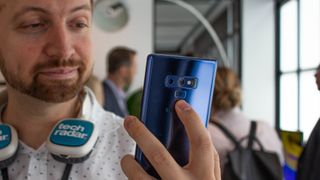
What a difference a year makes
Here’s something else you won’t get from Apple’s top phone: a fingerprint sensor that acts as an alternative to the iris scanner and Face Unlock.
It’s on the back of the Note 9, and centrally located this time. The Note 8 had a fingerprint reader on back, too, but it was off-center and led to lots of camera smudges. We hated it.
Camera and battery life
- Inherits the S9 Plus camera dual-aperture features
- Wide-angle and telephoto dual camera lenses on back
- AI-backed scene optimizer enhancements show promise
Samsung is carrying over its camera prowess to the Note 9, with low-light defeating and telephoto-zooming camera lenses on the back. The S9 Plus gave us a good idea of what to expect, but Samsung is promising even higher photo quality from the Note 9.
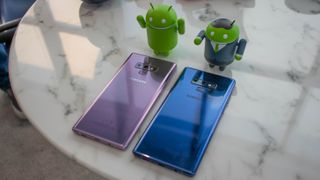
The dual 12MP rear camera uses dual aperture technology to switch between an f/1.5 aperture for low-light photography and an f/2.4 aperture for normal lighting conditions. The S9 Plus gave us positive results even in the darkest settings, boosting its rank as the best camera phone you can currently buy.
The secondary rear camera allows for a 2x optical zoom, giving you sharp telephoto snapshots for when you’re standing too far away. The aperture here is always set at f/2.4, and like the main lens it has optical image stabilization (OIS) to make up for your shaky hands.
The Note 9’s front-facing camera does selfies at 8MP and includes autofocus, a first for a Note phone. Samsung fills its camera app with an endless number of mode options, too: AR stickers, wide group selfies, and Super Slow Motion video at 960 frames per second at a 720p resolution. It’s one of the most robust camera apps in the business, yet easy to use.
Samsung demonstrated that the Note 9 camera identifies and adapts to various subjects with a new scene-optimizer feature.
It adjusts the white balance and color based on 20 subjects as varied as sunsets, flowers, food, birds, text and so forth. Compared to even the six-month-old S9 Plus, we saw the Note 9 camera exhibit much more detail from a macro flower photo.
The camera is supposed to understand what it’s looking at, and it uses the same technology to correct flaws, including eye blinking, image blurring, lens smudges, and backlight.
Sometimes it’ll pick the best photo of the bunch, and other times it’ll have a pop-up warning message, telling you to clean your dirty camera lens.
While rival Android handsets are supporting mobile HDR video recording, we don’t see signs of that here – we’re probably going to have to wait until the Galaxy S10 for superior, color-rich video.
Obviously, we'll be testing this camera thoroughly as we continue to review the Galaxy Note 9.
Android, interface and apps
- Android Oreo, just misses Android Pie
- Fortnite exlcusive (for a very limited time period)
- Smasung Pay, Bixby AI, and AR Emoji present
Samsung just missed the Android 9 Pie launch this week, meaning the Galaxy Note 9 comes with Android Oreo. Not that you’d notice, as Samsung puts its own spin on Android.
That’s not a bad thing any more. The Samsung Experience software is well refined in 2018, with helpful cues on how to navigate a deep and complex operating system. It’s much better than the bloated Samsung TouchWiz firmware on its old Android phones, and everyone who hates on the software today likely hasn’t touched a Samsung in years.
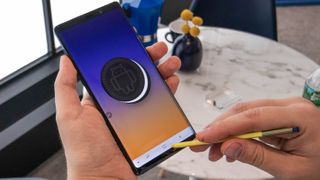
Samsung devices (Galaxy S7 and up) will be the first with access to the hit game Fortnite on Android through Samsung’s Game Center app.
It’s a six-day exclusive (which starts when the Note 9 launches) designed to give other Android users phone envy, as they'll have to wait, and sideload the app when the Samsung exclusivity expires – it won’t be downloadable in the Google Play app store. Beyond that, the Galaxy Note 9 and Tab S4 will receive an exclusive Fortnite skin that lasts forever.
Samsung Pay is the other app worth noting. It continues to be our favorite way to make contactless payments, simply because you can pay for things at credit card machines that don’t normally accept Apple Pay and Android Pay. Why no one has hopped on this is beyond us.
The Bixby AI assistant is here, but was unmentioned and untestable when we first played with the Note 9, and we had to inquire about AR Emoji to get details about the avatar refinements. These are not showstoppers for the Note 9.
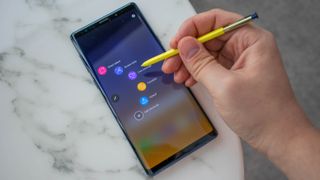
Early verdict
The Note 9 offers a lot to like – and a price hike to utterly dislike. The S Pen has new remote-controlled tricks, the maximum storage size is unbeatable, and the battery life and AI-enhanced camera are both promising.
The latter two perks require more review testing, but our initial impressions are quite favorable.
It’s just that you’ll pay through the nose for this bundle of little upgrades at a time when the Note 8 is a fine phone at a discounted price. When Samsung told us that the ideal user for the Note is someone who wants to own the best AV receiver, Best TV, and so forth, they may have left out the best airplane, the best yacht, and the best sports car.
The iPhone X drove prices to this level, and we complained then, too. Samsung is at least giving you more ‘big’ for your money.

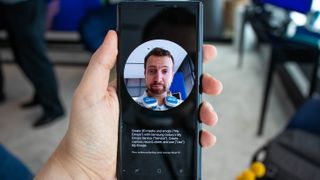
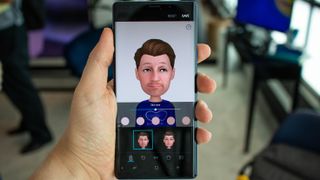






EmoticonEmoticon